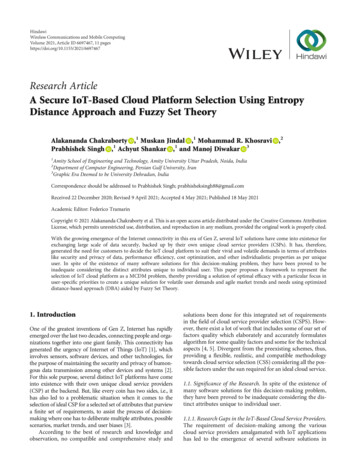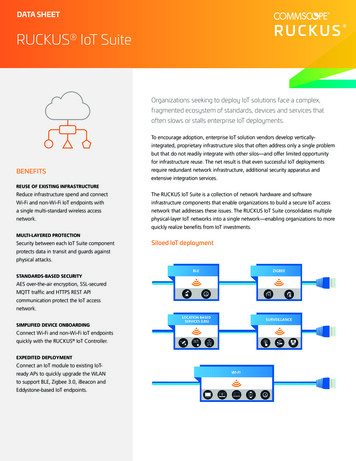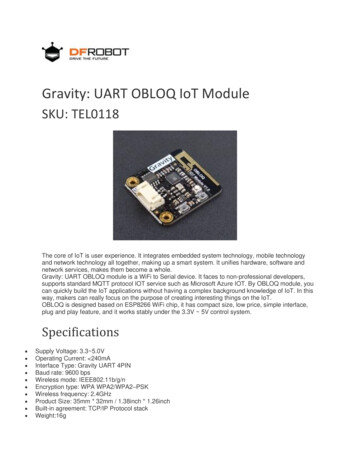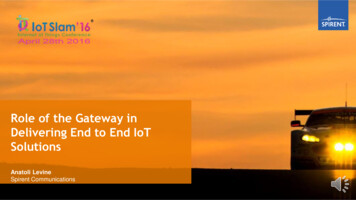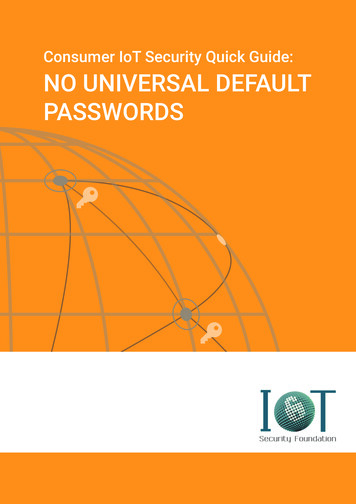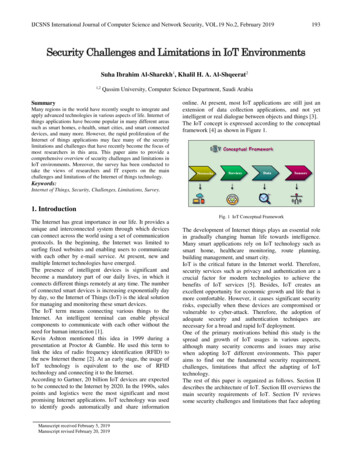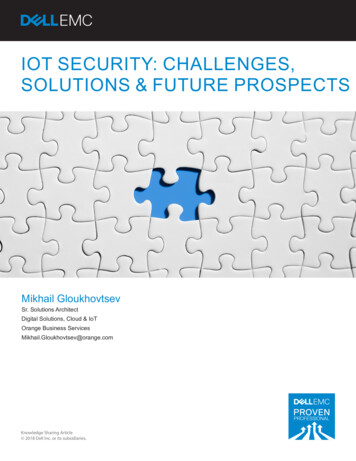
Transcription
IOT SECURITY: CHALLENGES,SOLUTIONS & FUTURE PROSPECTSMikhail GloukhovtsevSr. Solutions ArchitectDigital Solutions, Cloud & IoTOrange Business ServicesMikhail.Gloukhovtsev@orange.comKnowledge Sharing Article 2018 Dell Inc. or its subsidiaries.
Table of Contents1.Introduction . 51.1 What Is IoT? . 51.2 Security Role in the IoT Development . 72.IoT Security and IoT Architectures . 82.1 IoT Architectures . 82.1.1 IoT Components. 82.1.2 IoT Architectures and IoT Security . 103.IoT Security Challenges . 133.1 IoT Security Risks and Challenges . 133.2 IoT Security Threats and Attacks. 143.2.1 Attack Categorization For IoT Process Phases . 153.2.2 Attack Categorization According to IoT Architecture . 163.2.2.1 Security Threats at the Sensing/Perception Layer . 173.2.2.2 Security Threats at the Network and Service Support Layers . 184.IoT Security Requirements . 195.Trust, Data Confidentiality, and Privacy in IoT . 215.1 Trust in IoT . 215.1.1 Trust and Security from a Device Perspective . 215.1.2 Trust and Secure Key Storage . 225.1.3 Identity Management . 235.2 Data Confidentiality in IoT . 235.3 Privacy in IoT. 246.Security in IoT Networks . 256.1 Overview of IoT Communication Technologies . 256.2. Security in Short-Range Low Power IoT Networks . 272018 EMC Proven Professional Knowledge Sharing2
6.2.1. 6LoWPAN Security . 276.2.2. Security in RPL . 276.2.3 Security in Bluetooth Low Energy (BLE) . 286.2.4 Zigbee Security . 286.2.5 RFID Security . 296.2.6 Security in NFC . 316.3 Security in Long-Range Low Power IoT Networks . 326.3.1 Security in LPWAN: LoRa and LoRaWAN . 326.3.2 Security in LPWAN: NB-IoT and LTE-M . 347.Managed IoT Security Services: IoT Security-as-a-Service . 358.IoT Security in Public Cloud . 368.1 Security Features of IoT Cloud Solutions . 368.2 IoT Security in Azure . 368.3 IoT Security in AWS . 378.4 IoT Security in Google Cloud Platform . 379.Security in the Future IoT Systems . 379.1 Main Trends in the Next Generation IoT Security . 379.2 Next Generation IoT Security: Data Confidentiality. 399.2.1 Homomorphic Encryption . 399.2.2 Searchable Encryption . 399.3 Next Generation IoT Security: Trust . 399.3.1 Trust Establishment . 399.3.2 Blockchain and IoT: Trust in Transactions . 399.3.3 Trust in Platforms . 409.3.4 Identity Management . 409.4 Next Generation IoT Security: Privacy . 409.4.1 Privacy Through Data Usage Control . 402018 EMC Proven Professional Knowledge Sharing3
9.4.2 Privacy in Multifaceted and Dynamic Contexts . 4010.Conclusion . 4111.References . 41Disclaimer: The views, processes or methodologies published in this article are those of theauthor. They do not necessarily reflect Dell EMC’s views, processes or methodologies.2018 EMC Proven Professional Knowledge Sharing4
1. Introduction1.1 What Is IoT?The concept of the Internet of Things (IoT) was introduced by Kevin Ashton, a co-founder of theAuto-ID Center at MIT, in 1998.1 The vision is that objects (“things”) are connected to each otherand thereby they create IoT in which each object has its distinct identity and can communicatewith other objects. IoT objects can vary dramatically in size from a small wearable device to acruise ship. IoT transforms ordinary products such as cars, buildings, and machines into smart,connected objects that can communicate with people, applications and each other.There are various definitions of IoT. The International Telecommunication Union (ITU) defined theterm Internet of Things as "Internet of Things will connect the world's objects in both a sensoryand intelligent manner".2 In 2014, the Joint Technical Committee of the International Organizationfor Standardization (ISO) and the International Electrotechnical Commission (IEC) defined IoT as“an infrastructure of interconnected objects, people, systems and information resources togetherwith intelligent services to allow them to process information of the physical and the virtual worldand react”.3 At the IoT reception layer (Section 2.1.2), sensors placed within devices, objects, andmachinery collect, measure, and record information about the physical environment, such astemperature, humidity, gas pressure, and motion. This information can be read, integrated andanalyzed at higher IoT layers.NIST uses two acronyms, IoT and NoT (Network of Things).4 IoT is considered a subset of NoT,since IoT has its “things” connected to the Internet. In contrast, some types of NoT use only LocalArea Networks (LAN), with none of their “things” connected to the Internet.2018 EMC Proven Professional Knowledge Sharing5
Figure 1: Key Business Drivers for IoT DevelopmentThe IoT growth is driven by business needs as part of enterprise digital transformation (Fig. 1).According to Machina Research,5 the total number of IoT connections will grow from six billion in2015 to 27 billion by 2025. It means a compound annual growth rate (CAGR) of 16%. In termsof market growth, the Berg Insight report5 predicts an increase of the global third party IoTplatform market from 610m in 2015 to 3.05bn in 2021.Figure 2: IoT Connecting Technologies and Disparate Industries2018 EMC Proven Professional Knowledge Sharing6
IoT solutions not only involve various technology domains such as mobile communications, cloud,data, security, telecommunications, and networking but they also lead to cross-industrial use ofdata (for example, data generated in smart home and industrial applications is used in theautomotive domain) (Fig. 2). This opens a possibility for establishing business partnershipsbetween horizontal industries, such as telecommunication operators, and vertical industries, suchas car manufacturers, as new business models. IoT-enabled digital transformation of business ismuch more than just using connected objects – it makes it possible to develop innovative businessmodels that were impossible before.1.2 Security Role in the IoT DevelopmentAs discussed above, IoT is growing fast across various industry verticals along with increases inthe number of interconnected devices and variety of IoT applications. However, IoT technologiesare not mature yet and there are many challenges to overcome. Security is the most significantof them. There are millions of connected devices and billions of sensors and their numbers aregrowing. All of them need secure and reliable connectivity. Hence, well-designed security IoTarchitectures are required by companies and organizations adopting IoT technologies.Indeed, the IoT threat landscape is large and growing: the attack surface is very large, as any IoTdevice could be a possible attack target. Some IoT devices are located in untrusted areas andattackers can gain physical access to them and even get control of the device. Many IoT devicesdo not meet security best practices requirements such as least-privileged or role-based access.For example, many smart-home IoT devices such as TVs, webcams, home thermostats, remotepower outlets, sprinkler controllers, home alarms, door locks, and garage door openerscommunicate over the network without any form of encryption and do not offer the user thepossibility to enable strong passwords. IoT devices are resource-constrained and are designedto consume little power while at the same time providing all required functionality at a reasonablecost. As a result, security is an after-thought, often placed at the bottom of the priority list in thedevelopment lifecycle.IoT attack vectors can target devices, gateways, SIM/cell, transceivers, and wearables and cantake advantage of weak passwords, lack of encryption, backdoors, etc.The wide variety of IoT-specific operating systems, firmware versions (Section 2.1.2, Table 1),and custom configurations makes development of general IoT security solutions difficult.Monitoring and patching the various IoT OSes is a tremendous challenge. Furthermore, IoT2018 EMC Proven Professional Knowledge Sharing7
security solutions should be extremely scalable to apply to an exponentially increasing number ofvarious IoT devices. A growing variety of IoT applications creates new security challenges. Inaddition to traditional security domains such as cryptography, secure communication, and privacyassurances, IoT security also focuses on trust/identity management (Section 5.1), dataconfidentiality (see Section 5.2), privacy protection (Section 5.3), etc.This article considers IoT security challenges, security requirements for IoT architecture, currentsecurity solutions and new evolving technologies. I hope my article will help the readers inselecting secure IoT technologies for their businesses.2. IoT Security and IoT Architectures2.1 IoT ArchitecturesAs IoT uses a very broad range of various technologies (Table 1),6 it is not possible to design asingle reference architecture that can be used as a blueprint for all conceivable implementations.Hence, several reference architectures will co-exist in IoT. Before we consider various referenceIoT architectures and security implementations in them in detail, let’s take a look at IoTcomponents.2.1.1 IoT ComponentsWhile there are many different IoT architecture patterns (see Section 2.1.2), they all share onecommon set of components – a three-tier topology consisting of physical device, edge, andplatform.Physical Devices. All IoT physical devices have a common attribute – their individual identity asa physical device. The ability to uniquely identify “things”' is critical in IoT as it enables not onlyunique identification of billions of devices but also control of remote devices through the Internet.The physical devices may have some level of computing power that is either embedded in thedevice or directly attached in the form of their actuators or controllers. Connectivity varies fromdevices connected directly to other physical devices or to edge and to connectivity to one or moreIoT systems. Today device security is largely implemented on a case-by-case basis in connectionwith customer demands and capabilities.Edge. Sensors, controllers, actuators, tags and tag readers, communication components,gateways and the physical devices are components that form the edge. At the edge tier data fromall the end-nodes is collected, aggregated, and transmitted over the proximity network to a bordergateway. The edge sizes run the gamut from a small single physical device with a direct connect2018 EMC Proven Professional Knowledge Sharing8
to a platform to a large manufacturing plant comprising all manufacturing equipment with acommunications functional component and edge computing platform, or anything in between.Platform. The data from the edge tier is sent over the access network to the platform that isresponsible for data transformation and processing. The platform tier also manages control dataflowing in the other direction, for example, from the enterprise to the edge tiers. The majority ofthe functions related to the information and operations domains is at the platform tier.Depending on the scale and timeliness requirements of IoT applications, the data will be eitherstreamed to a centralized cloud (see Section 8) or will require distributing storage and computeto the edges —- closer to the devices. The latter is typical for applications generating data volumesthat are too large to be affordably transferred to a centralized cloud. Architecture with dataprocessing closer to where data is generated or used is called Fog Computing.7 Fog Computingcan be seen as an extension of the cloud to deploy cloud services closer to the “things” thatproduce IoT data.7 From the IoT security perspective, Fog Computing architecture provides bettersecurity as it keeps sensitive data inside the network and the data spends less time in transit.Moving security capabilities into the edge is the easiest way to protect endpoints and devicesbehind the gateway in a uniform manner. Dell and other major IoT solution providers are workingon the vendor-neutral, open source project EdgeX Foundry.8 The goal is to provide the openinterop platform for the IoT edge with the simplification and standardization of the IoT edgeframework.Another classification of IoT components is presented by NIST, which considers IoT a technologydomain involving sensing, computing, communication and actuation.4 The NIST IoT guidelinedefines five core primitives: sensor, aggregator, communication channel, external utility anddecision trigger. The term “primitive” is related to smaller blocks from which larger blocks orsystems can be built. These primitives are considered the building blocks for a Network of Things(NoT) that includes IoT as a subdomain. The model also defines six elements — environment,cost, geographic location, owner, Device ID, and snapshot that are key factors in IoTtrustworthiness. The concept of primitives and elements makes it easier to develop IoT securitysolutions. For example, while issues such as geo-location and sensor ownership can beaddressed by implementing authentication, authentication may not be relevant if an adversarygains control of the sensors.2018 EMC Proven Professional Knowledge Sharing9
2.1.2 IoT Architectures and IoT SecurityAs we mentioned in Section 2.1, the variety of IoT applications has resulted in various IoTarchitecture models. We start with a three-layer architecture:91. Perception layer2. Network layer3. Application layerThe perception layer – also called the recognition layer9 – is the lowest layer of the conventionalarchitecture of IoT. This layer is responsible for collecting data from “things” or the environment(such as Wireless Sensor Networks [WSN], heterogeneous devices, sensors, etc.) andprocessing them.Some other models include one more layer: a support layer that lies between the application layerand network layer. For example, the ITU-T (International Telecommunications Union Telecommunication Standardization Sector) suggests a layered IoT architecture that is composedof four layers (Fig. 3).10 The IOT application layer containing the application user interface is thetop layer. The services and application support layer is the second layer from the top. The thirdlayer is the network layer which contains the networking and transport capabilities. Finally, thelowest layer is the device layer, which contains gateways, sensors, RFID tags, etc. The securitycapabilities categorized into generic and specific (Fig. 3), are distributed along all four layers.2018 EMC Proven Professional Knowledge Sharing10
Figure 3: IoT layered Architecture (Ref.10)The IoT European Research Cluster (IERC) adds more details to the ITU-T architecture of IoT bypresenting the functions included in every layer (Fig. 4).11 For example, the third layer – thenetwork and communication layer – includes the network and communication capabilities suchas gateway, routing and addressing, energy optimization, QoS (Quality of Service), flow controland reliability, and error detection and correction. The security management functions listed onthe right side include authorization, key exchange and management, trust, identity managementand authentication. We will review these IoT security functions in detail later (Sections 4-6).Cisco has suggested a seven-level IoT reference model describing the functionality each levelshould have.12 Figure 5 shows the Cisco IoT reference model and its levels. Data flows in themodel are in both directions. While control information flows from the top of the model (Level 7)to the bottom (Level 1), the flow of information is the reverse in a monitoring pattern. The securitymeasures presented in the Cisco IoT Reference must (1) secure each device or system; (2)provide security for all processes at each level; and (3) secure movement and communicationbetween each level, whether north- or south-bound. Therefore, the security functions are spreadthrough all the levels, as shown in Figure 5.2018 EMC Proven Professional Knowledge Sharing11
Figure 4: Detailed IoT Layered Architecture (Ref.11)Figure 5: Pervasive Security throughout the IoT Reference Model (Ref.12)2018 EMC Proven Professional Knowledge Sharing12
To complete our review of the IoT architecture models, we list some IoT technologies used atvarious architecture layers (Table 1).13Communication TechnologiesNFC, RFID, ANT, Bluetooth, Zigbee, Z-Wave, IEEE802 15.4, Wi-FiWiMAX, Weightless, DASH7, EnOcean, PLC, QR Code, EthernetGPRS, GSM, GPS, 3G/4G, LTE, Satellite, LoRaWANPrototype HardwareRaspberry Pi, Hackberry, Arduino Yun, Arduino Uno, PCDuino, The Rascal, Cubie Board,BeagleBone Black, OpenPicus Flyport Wi-Fi, PinoccioOperating SystemTiny OS, Contiki, Mantis, Nano-RK, LiteOS, FreeRTOS, Riot OS, SNAP OS, Abacus OS,Sapphire OSProtocolREST, IPv6, 6LoWPAN, UDP, LoRa, LoRaWAN, DTLS, XMPP-IoT, SSI, NanoIP, MQTTShort rangeMedium rangeLong rangeTable 1: IoT TechnologiesIn this article, we discuss the security aspects of some of these technologies (Section 6).3. IoT Security Challenges3.1 IoT Security Risks and ChallengesThree categories of IoT risks include:1. Risks that are typical in any Internet system2. Risks that are specific to IoT devices3. Safety to ensure no harm is caused by misusing actuators, for instance.Traditional security practices such as locking down open ports on devices belong to the firstcategory (for example, a fridge connected to the Internet in order to send alerts about the productinventory and temperature may use an unsecured SMTP server and can be compromised by abotnet). The second category includes issues specifically related to IoT hardware, e.g. the devicemay have its secure information compromised. For example, some IoT devices are too small tosupport proper asymmetric encryption. Furthermore, any device that can connect to the Internethas an embedded operating system deployed in its firmware and many of these embeddedoperating systems are not designed with security as their primary consideration.2018 EMC Proven Professional Knowledge Sharing13
In order to make IoT services available at low cost with a large number of devices communicatingsecurely to each other, there are many security challenges to overcome. We will briefly reviewsome main challenges.Scalability: Managing a large number of IoT nodes requires scalable security solutions.Connectivity: In IoT communications (Section 6), connecting various devices of differentcapabilities in a secure manner is another challenge.End-to-End Security: End-to-end security measures between IoT devices and Internet hostsare equally important.Authentication and Trust: Proper identification and authentication capabilities and theirorchestration within a complex IoT environment are not yet mature. This prevents establishmentof trust relationships between IoT components, which is a prerequisite for IoT applicationsrequiring ad-hoc connectivity between IoT components, such as Smart City scenarios. Trustmanagement for IoT is needed to ensure that data analytics engines are fed with valid data(Section 5.1). Without authentication it is not possible to ensure that the data flow produced by anentity contains what it is supposed to contain.Identity Management: Identity management is an issue as poor security practices are oftenimplemented. For example, the use of clear text/Base64 encoded IDs/passwords with devicesand machine-to-machine (M2M) is a common mistake. This should be replaced with managedtokens such as JSON Web Tokens (JWT) used by OAuth/OAuth2 authentication andauthorization framework (the Open Authorization).Attack-Resistant Security Solutions: Diversity in IoT devices results in a need for attackresistant and lightweight security solutions. As IoT devices have limited compute resources, theyare vulnerable to resource enervation attacks.3.2 IoT Security Threats and AttacksTo emphasize security risks in IoT, its acronym has been presented as Interconnection of Threats(IoT).14 Indeed, IoT devices are particularly vulnerable to physical attacks, software attacks, sidechannel attacks, and so on as presented in Table 2.2018 EMC Proven Professional Knowledge Sharing14
ThreatsAttack ProcedurePhysicalattacksEnvironmentattacksTamper with the hardware andother components.The device encryption key canbe discovered by the attackerby recovering the encryptioninformation.Find ciphertext to break xploit vulnerabilities in thesystem during its owncommunication interface andinject malicious ecureencryptionschemeLayout reconstruction,micro-probingTiming attack, sidechannel attack, faultanalysis attackSecureencryptionschemeProper antivirusupdateKnown-plaintextattack, chosenplaintext attackTrojan horse, worms,or virusesTable 2: Security Threats to IoT Devices (Ref.13)Current IoT platforms are built using technology solutions from a wide variety of vendors. Someof these platforms are an eclectic mix of components repurposed from existing solutions for usein specifically designed platforms with the hope that the components will work together in a secureway. Security measures within the IoT components, if any, have not been designed to take intoaccount the dependencies resulting from the IoT connectivity capabilities. For example, industrialdevices often do not have proper authentication mechanisms because they have been designedto be used in physically protected and isolated environments. Another example is the challengeof providing software updates or security patches in a timely manner to end nodes withoutimpairing functional safety.Comprehensive risk and threat analysis methods as well as management tools for IoT platformsare required. Developing mitigation plans for IoT attacks requires understanding attack types andthe sequence of actions taking place when the attacks are happening. Let us start with consideringIoT attack categorization. Analysis of security attacks helps to understand an actual view of theIoT networks and enables us to determine mitigation plans.3.2.1 Attack Categorization For IoT Process PhasesIn general, an IoT process can be considered as a five phase sequence, from data collection todata delivery to the end users.14 Table 3 demonstrates the variety of attacks categorized for thefive phases of IoT: data perception, storage, intelligent processing, data transmission, and endto-end delivery.2018 EMC Proven Professional Knowledge Sharing15
PhaseAttack/ThreatDescriptionData Perception: VariousData Leakage or Breach, DataData leakage can be internaltypes of data collectors can beSovereignty, Data Loss, Dataor external, intentional orused. The device may be aAuthentication.unintentional, involvingstatic body (body sensors orhardware or software.RFID tags) or a dynamicvehicle (sensors and chips).Storage. If the device has itsAttack on Availability, AccessAvailability is one of theown local memory, data canControl, Integrity, Denial ofprimary security concerns.be stored. In the case ofService, Impersonation.Distributed denial of servicestateless devices, the data can(DDoS) is an overloadbe stored in the cloud.condition that is caused by ahuge number of distributedattackers.Intelligent ProcessingAttack on authenticationAn IoT solution provides dataanalysis and intelligentservices in real time.Data TransmissionEnd-to-End DeliveryChannel security, sessionThreats in transmission, suchhijack. Routing protocols,as interrupting, blocking, dataflooding.manipulation, forgery, etc.Man or machine. Maker orDelivery of processed data onhacker.time without errors oralteration.Table 3: Attack Taxonomy According to the IoT Process Phases3.2.2 Attack Categorization According to IoT ArchitectureAs discussed in Section 2.1, there are various IoT architecture models. In general, the IoTarchitecture is assumed to have four layers, presented in Fig. 3. We will briefly review the mainsecurity threats at the perception, network, and service layers. The most important securityconcerns in IoT presented as four-layer architecture (Fig. 3) are summarized in Table 4.2018 EMC Proven Professional Knowledge Sharing16
Security ConcernsApplication &Interface LayerServiceSupport LayerNetworkLayerDeviceLayerInsecure web interface Insufficientauthentication/authorization Insecure network services Lack of transport encryption Privacy concerns Insecure cloud interface Insecure mobile interface Insecure security configuration Insecure software/firmware Poor physical security Table 4: Top Ten Vulnerabilities in IoT (Ref.15)3.2.2.1 Security Threats at the Sensing/Perception LayerTo fully implement IoT security, it must be designed and built into the devices themselves. Thismeans that IoT devices must be able to prove their identity, maintain authenticity, sign and encrypttheir data to maintain integrity, and limit locally stored data to protect privacy. The security modelfor devices must be strict enough to prevent unauthorized use but flexible enough to supportsecure ad hoc interactions with people and other devices on a temporary basis. For example,while unauthorized changing of the toll rate on a connected parking meter should be prevented,the meter should have a se
IoT architectures and security implementations in them in detail, let's take a look at IoT components. 2.1.1 IoT Components While there are many different IoT architecture patterns (see Section 2.1.2), they all share one common set of components - a three-tier topology consisting of physical device, edge, and .
